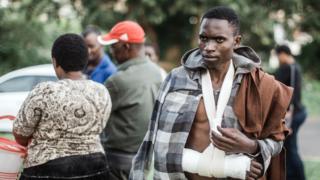Are attacks on foreigners rising in South Africa?
A group of unemployed men attacked Malawian migrants living in the South African city of Durban at the end of March.
It followed a recent spate of other incidents in the city during the month, prompting leaders from the three main parties to condemn attacks on foreign nationals.
The upsurge in violence has become a charged issue in the campaign ahead of national elections in May.
So how common are attacks against migrants and are they on the rise?
Attacks against foreigners
The South African government does not collect data on attacks or threats against foreign nationals.
However, the African Centre for Migration & Society (ACMS) has monitored these attacks across South Africa since 1994. Its Xenowatch tracker collates media reports as well as information from activists, victims and observers.
Threats, attacks and killings against foreigners in South Africa
It suggests violent attacks peaked in 2008 and again in 2015.
In 2008, there was a wave of attacks across the country against refugees and migrants – more than 60 people were reported to have been killed and thousands displaced.
In 2015, there were outbreaks of violence against non-South Africans, mostly in the cities of Durban and Johannesburg, which led to the deployment of the army to deter further unrest.
In March, the government launched an initiative to raise public awareness and improve access to services for victims of discrimination.
Human rights groups welcomed it, but said that the government needed to publicly recognise attacks on foreigners as xenophobic.
In a statement published in October, South Africa’s main opposition party, the Democratic Alliance, blamed the governing ANC party for a “scourge of xenophobic violence”.
Where are the migrants from?
About 70% of foreigners in South Africa come from neighbouring Zimbabwe, Mozambique and Lesotho.
The remaining 30% is made up of people from Malawi, UK, Namibia, eSwatini, previously known as Swaziland, India and other countries.
There are an estimated 3.6 million migrants in the country, a spokesperson for South Africa’s national statistics body told the BBC, out of an overall population of well over 50 million.
How do different regions compare?
Gauteng province, which includes South Africa’s largest city Johannesburg and the capital Pretoria, has the highest rate of violence against foreign nationals, followed by the Western Cape, according to the ACMS. KwaZulu-Natal, where Durban is situated, is third.
Attacks have mainly taken place in large cities, but they have also been reported in smaller towns and rural areas.
The violence is often triggered by local disputes, with migrants being accused of taking jobs away from South Africans.
Foreign-run shops have been looted and destroyed.
South Africa attacks
The country has experienced poor economic performance, with officially recorded unemployment at more than 27% at the end of last year.
And more widely, the country has one of the highest murder rates in the world.
“The causes are poverty and has its roots in apartheid,” says Sharon Ekambaram, who runs the refugee and migrant rights programme for Lawyers for Human Rights.
What do you want BBC Reality Check to investigate? Get in touch
Read more from Reality Check
Follow us on Twitter
Source: Read Full Article



